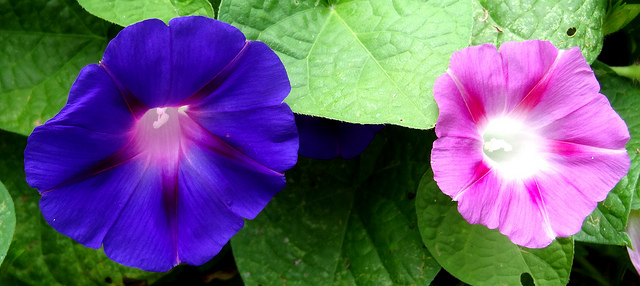How to Grow and Care for Morning Glories
The Legend of the Morning Glory
According to legend, there once lived a beautiful princess who loved flowers. She visited the garden every morning, but being delicate in nature when the sun rose high in the sky she was overcome by the heat and had to return inside. Because all the flowers bloomed when the sun was high in the sky, the poor princess never got to enjoy their beauty. One day, as she entered the palace she began to cry as it broke her heart to leave before seeing the beautiful flowers in bloom. As her tears fell upon the earth, they magically turned to seeds where they took root and began to grow. One bright morning the princess was greeted with beautiful morning glories in full bloom long before the sun rose high in the sky. To this day, the morning glory blooms at dawn and shrivels and closes under the mid-day sun.
The Origin of the Morning Glory
Native to tropical America, wild morning glories produce small white blooms that open in the early morning and shrivel under the rays of the sun. Until the turn of the century, morning glories were grown simply to cover unsightly buildings or structures.
One day in 1931, a man named Clarke happened upon a field of morning glories in Colorado that produced sky-blue blooms and held their blooms into the morning. This gave rise to 'Clarke's Heavenly Blue Morning Glories.' Others soon produced an assortment of colors making this a popular flower in home gardens.
One day in 1931, a man named Clarke happened upon a field of morning glories in Colorado that produced sky-blue blooms and held their blooms into the morning. This gave rise to 'Clarke's Heavenly Blue Morning Glories.' Others soon produced an assortment of colors making this a popular flower in home gardens.
Tips for Growing Morning Glories
- Light: Morning glories prefer full sun for 6 to 8 hours a day but will tolerate light shade. Areas with bright morning sun, some shade during the heat of the day, and direct sunlight in the afternoon are ideal for morning glories.
- Soil: Morning glories prefer poor soil and will grow in nearly any soil as long as it drains well. Avoid adding fertilizer or amending it heavily with organic matter as the added nutrients may cause lush foliage with few blooms.
- Preparing Seeds: Morning glory seeds have a hard seed coat and benefit from either soaking in warm water overnight or nicking the seed coat. Some prefer to file a small notch in the outer coat of the seed to allow moisture to enter and germination to begin. If you choose to nick the seed, use nail clippers, but use caution not to cut too deeply and injure the embryo inside the seed.
- Planting: Plant morning glory seeds in the spring after all danger of frost has passed in your area. Plant the seeds to a depth of 1/2-inch spaced 6 inches apart along a fence or in front of a trellis. Cover them with soil and firm the soil down with your hands to secure the seeds.
- Water: Water to moisten the soil to the depth of the seeds when first planting and keep the soil moist until seedlings emerge in 7 to 21 days, depending on the soil temperature and weather conditions. Reduce watering to once or twice a week (or whenever the soils dries) when the seedlings are established.
- Thinning: Thin morning glories to 8 to 10 inches apart to allow plenty of room for their vines to grow.
- Deadheading: Deadhead morning glories daily by removing the shriveled flowers from the vine. This prolongs the blooming period and improves the appearance of the plants.
